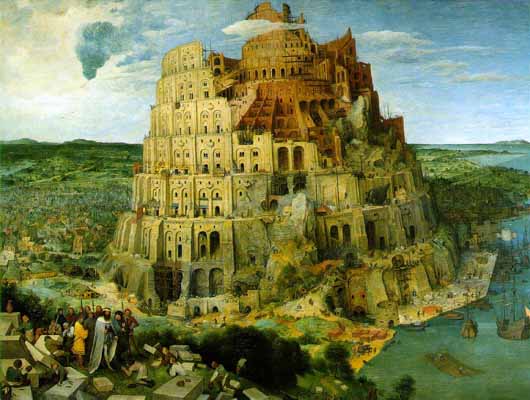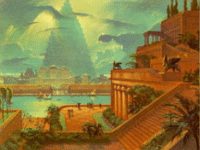

The mood of the political world seems to be for peace and prosperity. One seems to propagate the other. Prosperity needs peace (stock market, et al) and peace produces uninhibited prosperity. This seems to already be the New World Order's (NWO) agenda: a world economy with minimal trade restrictions and a peaceful world coexistence by early in the new millennium. Peace is being sought in Ireland, Bosnia/Kosovo, India (w/ Pakistan), N. Korea, not to mention the Middle East. If we're not yet within the first seal of Revelation, then we may be very close indeed!
Yet, I see four "problem" areas for future, unfulfilled bible prophecy with:
Israel must sign a peace treaty guaranteed for seven years. This can happen at any time, so this is no real problem.
Magog must then be ready to fulfill the prophecies of Ez. 38 & 39. Russia is ready militarily now, but lacks a nationalistic resolve. This could soon change as they're having serious economic woes and the elections in the year 2000 will probably produce a very nationalistic leader. This is only a minor problem.
The Antichrist also must consolidate his power block (10 nations or regions) and himself be revealed. This will happen within Daniel's 70th week. No real problem here either; it's completely dependent on problem #1 (The initialization Israel's seven year peace treaty).
Babylon, however, is the big problem as I see it in scripture. According to the future Babylon, described in Is. 13 & 14, Jere. 50 & 51 and Rev. 17 & 18, it must be a world economic and religious center literally located in what geographically today is Iraq. For this to happen, the Arab nations must first resolve their minor differences and consolidate into the world's greatest oil producing economic power block, able to cooperatively control the world oil prices, becoming exceedingly wealthy in the process. They (OPEC) tried to do this in the late 70's, but failed in their cooperation, only temporarily causing our (USA) oil crisis and thereby affecting a short lived oil boom here. Before this consolidation could take place however, Saddam Hussein must either be removed or change his colors so that he is no longer a threat to the west. (He seems to fit the bill as the Arab leader for this consolidation and has the vision of Iraq becoming, once again, the great Babylon.) After the Arab's consolidation, literal Babylon must then be built in Iraq.
Babylon (from Bab-ili, meaning "Gate of God") was known for it's power, wealth and as a great religious center. The "golden age" of Babylon was under the rule of Nebuchadnezzar. (Nebuchadnezzar II, the most important of the Chaldean, or Neo-Babylonian, kings, reigned from 605 to 562 BC. Although he is called Nebuchadnezzar in the Old Testament, his Babylonian name was Nabu-kudur-usur; modern historians often refer to him as Nebuchadrezzar.) Nebuchadnezzar is best remembered for his dealings with the Jews and as the builder of the Hanging Gardens of Babylon, one of the seven ancient wonders of the world. The remaining southern Jewish Kingdom of Judah was positioned between two great powers--Egypt and Babylonia. It was unable to remain either independent or neutral; if it aligned with one side, it would be battered by the other. In 597 and again in 586 when the kingdom was under Egyptian control, Jerusalem was besieged and captured by Nebuchadnezzar. The second time he destroyed the city and carried off the Jews into their lengthy Babylonian captivity (Jere. 25:11, 12). Daniel, himself being a captive, knew their seventy year captivity was about to end and so began fasting and praying for a period of twenty-one days resulting in the visions contained in the book of Daniel. The dream of the statue with a head of gold personified the future history of the Gentile nations (Dan. 2:29-45). The great Egyptian and Assyrian empires had already come and gone. Note that, interestingly, beginning with the head of gold, which is Babylon, the future kingdoms successively degenerate in their constitution: from gold to silver (Media-Persia) to bronze (Greek) to iron (Roman) and finally to miry clay mixed with iron (The Antichrist's ten "nation" consolidation).
Saddam Hussein, today's ruler of Iraq, began the rebuilding of Babylon over these ruins during the Iraq/Iran war to help keep his people from becoming demoralized because of this protracted and costly war. Later, after failing to secure control of the oil market, by the taking of Kuwait which lead to the Gulf War, Saddam, having received sanctions constraining Iraq, has been unable to complete the rebuilding of Babylon. Even so, he strongly identifies himself with the ancient ruler, Nebuchadnezzar, believing to be akin to him and having been "given" the vision to restore the once great empire and becoming it's ruler. It has been said that they even look alike!
Here's the big problem that I see: To rebuild Babylon into the economic world center, as described in the bible, it will take much money and time. Money will not be a problem when the Arab nations consolidate, but economic empires (cities) are not physically built overnight (e.g. Hong Kong). And until this is completed along with the temple for the world's religious center (see: Zech. 5:5-11; note: "in the land of Shinar" = Babylon = Iraq), then the prophecies can not be fulfilled. This is of concern, because it appears that this "problem" area will take some time to complete, thereby possibly moving the future, yet unfulfilled prophetic events well into the next century (and millennium). The only consolation is the proposition that with the "New World Order" (NWO), all nations cooperating together as with Babel (Gen. 11:1-9), this could then speed up the progress of rebuilding Babylon. After the flood mankind built Babel with one united purpose. God confused the language (with many languages) and further inhibited this "world order" by also separating the continents in Peleg's time (Gen. 10:25; 1 Chron. 1:19). Since then the world, with it's technology, has now overcome these two major obstacles placed by God. Thus, the way is clear for the NWO and the building of the great city Babylon (Rev. 18:9-21). Nevertheless, as I've said, considering these realities, it could still take some time to built such a great city that's the world's economic and religious center according to the biblical prophecies.
Finally, in the hermeneutics of bible eschatology there's a tendency to "spiritualize" a difficult passage that seems impossible to take literally. One must always remember the first rule of bible interpretation: Always interpret literally and use scripture to interpret scripture in understanding any allegories or symbols, etc.
Following are several examples why Babylon must be a literal, physical and a specific geographical location:
 In Babylon, Nebuchadnezzar engaged in numerous building projects. The great city was fortified, many temples were constructed, the great seven-staged, staired ziggurat Etemenanki, popularly associated with the Tower of Babel and the Hanging Gardens were all erected. The ziggurat, or temple tower, was the dominant feature of religious architecture. The ziggurat was probably thought of both as an altar and as a sort of stairway to and for the gods. Ishtar was the principle goddess of the religious cult worship of that day that involved prostitution and human sacrifice. Nebuchadnezzar's triple-walled city measured at least 11 miles (18 km ) around the perimeter. In the city, on the east bank of the Euphrates, stood the temple Esagila. Northward from Esagila, the Processional Way, decorated with animals in glazed and relief brickwork, led through the Ishtar Gate (now in the Berlin Museum) to the New Year (Akitu) temple. Northwest of the Processional Way stood Nebuchadnezzar's palace. Vaulted structures at its northwest corner may be ruins of the legendary Hanging Gardens. History indicates that Alexander the Great, who occupied Babylon in the forth century B.C., dismantled Nebuchadnezzar's tower. He had planned to refurbish and rebuild it but died before accomplishing his wish. Alexander's successor carted the stones away to build a new capital elsewhere.
In Babylon, Nebuchadnezzar engaged in numerous building projects. The great city was fortified, many temples were constructed, the great seven-staged, staired ziggurat Etemenanki, popularly associated with the Tower of Babel and the Hanging Gardens were all erected. The ziggurat, or temple tower, was the dominant feature of religious architecture. The ziggurat was probably thought of both as an altar and as a sort of stairway to and for the gods. Ishtar was the principle goddess of the religious cult worship of that day that involved prostitution and human sacrifice. Nebuchadnezzar's triple-walled city measured at least 11 miles (18 km ) around the perimeter. In the city, on the east bank of the Euphrates, stood the temple Esagila. Northward from Esagila, the Processional Way, decorated with animals in glazed and relief brickwork, led through the Ishtar Gate (now in the Berlin Museum) to the New Year (Akitu) temple. Northwest of the Processional Way stood Nebuchadnezzar's palace. Vaulted structures at its northwest corner may be ruins of the legendary Hanging Gardens. History indicates that Alexander the Great, who occupied Babylon in the forth century B.C., dismantled Nebuchadnezzar's tower. He had planned to refurbish and rebuild it but died before accomplishing his wish. Alexander's successor carted the stones away to build a new capital elsewhere.
Charles H. Dyer, The Rise of Babylon (Wheaton, Illinois: Tyndale House Pub., Inc., c. 1991).
Bruce Corbin, Babylon the Great (Guthrie, Okla.: Truth Pub. Co., 1941).
The New Grolier Mulitmedia Encyclopedia, 1993 ed., s.v. "Babylon; Nebuchadnezzar."
New American Standard Bible Reference Edition (La Habra, Calif.: Foundation Press Pub., 1973).